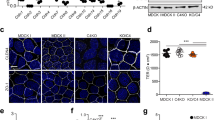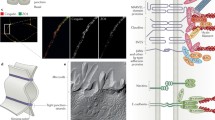Abstract
Sealing of the paracellular cleft by tight junctions is of central importance for epithelia and endothelia to function as efficient barriers between the extracellular space and the inner milieu. Occludin and claudins represent the major tight junction components involved in establishing this barrier function. A special situation emerges at sites where three cells join together. Tricellulin, a recently identified tetraspan protein concentrated at tricellular contacts, was reported to organize tricellular as well as bicellular tight junctions. Here we show that in MDCK cells, the tricellulin C-terminus is important for the basolateral translocation of tricellulin, whereas the N-terminal domain appears to be involved in directing tricellulin to tricellular contacts. In this respect, identification of homomeric tricellulin-tricellulin and of heteromeric tricellulin-occludin complexes extends a previously published model and suggests that tricellulin and occludin are transported together to the edges of elongating bicellular junctions and get separated when tricellular contacts are formed.





Similar content being viewed by others
References
Staehelin LA (1973) Further observation on the fine structure of freeze-cleaved tight junctions. J Cell Sci 13:763–786
Schulzke JD, Fromm M (2009) Tight junction: molecular structure meets function. Ann NY Acad Sci 1165:1–6
Furuse M, Tsukita S (2006) Claudins in occluding junctions of humans and flies. Trends Cell Biol 16:181–188
Ikenouchi J, Furuse M, Furuse K, Sasaki H, Tsukita S, Tsukita S (2005) Tricellulin constitutes a novel barrier at tricellular contacts of epithelial cells. J Cell Biol 171:939–945
Martin-Padura I, Lostaglio S, Schneemann M, Williams L, Romano M, Fruscella P, Panzeri C, Stoppacciaro A, Ruco L, Villa A, Simmons D, Dejana E (1998) Junctional adhesion molecule, a novel member of the immunoglobulin superfamily that distributes at intercellular junctions and modulates monocyte transmigration. J Cell Biol 142:117–127
Cohen CJ, Shieh JT, Pickles RJ, Okegawa T, Hsieh JT, Bergelson JM (2001) The coxsackievirus and adenovirus receptor is a transmembrane component of the tight junction. Proc Natl Acad Sci USA 98:15191–15196
Tsukita S, Furuse M, Itoh M (2001) Multifunctional strands in tight junctions. Nat Rev Mol Cell Biol 2:285–293
Furuse M, Hirase T, Itoh M, Nagafuchi A, Yonemura S, Tsukita S, Tsukita S (1993) Occludin: a novel integral membrane protein localizing at tight junctions. J Cell Biol 123:1777–1788
Saitou M, Furuse M, Sasaki H, Schulzke JD, Fromm M, Takano H, Noda T, Tsukita S (2000) Complex phenotype of mice lacking occludin, a component of tight junction strands. Mol Biol Cell 11:4131–4142
Schulzke JD, Gitter AH, Mankertz J, Spiegel S, Seidler U, Amasheh S, Saitou M, Tsukita S, Fromm M (2005) Epithelial transport and barrier function in occludin-deficient mice. Biochim Biophys Acta 1669:34–42
Krause G, Winkler L, Mueller SL, Haselhoff RF, Piontek J, Blasig IE (2008) Structure and function of claudins. Biochim Biophys Acta 1778:631–645
Furuse M, Hata M, Furuse K, Yoshida A, Sugitani Y, Noda T, Kubo A, Tsukita S (2002) Claudin-based tight junctions are crucial for the mammalian epidermal barrier: a lesson from claudin-1-deficient mice. J Cell Biol 156:1099–1111
Amasheh S, Schmidt T, Mahn M, Florian P, Mankertz J, Tavalali S, Gitter AH, Schulzke JD, Fromm M (2005) Contribution of claudin-5 to barrier properties in tight junctions of epithelial cells. Cell Tissue Res 321:89–96
Wen H, Watry DD, Marcondes MC, Fox HS (2004) Selective decrease in paracellular conductance of tight junctions: role of the first extracellular domain of claudin-5. Mol Cell Biol 24:8408–8417
Amasheh S, Meiri N, Gitter AH, Schöneberg T, Mankertz J, Schulzke JD, Fromm M (2002) Claudin-2 expression induces cation-selective channels in tight junctions of epithelial cells. J Cell Sci 115:4969–4976
Günzel D, Amasheh S, Pfaffenbach S, Richter JF, Kausalya PJ, Hunziker W, Fromm M (2009) Claudin-16 affects transcellular Cl− secretion in MDCK cells. J Physiol (Lond) 587:3777–3793
Hou J, Paul DL, Goodenough DA (2005) Paracellin-1 and the modulation of the ion selectivity of tight junctions. J Cell Sci 118:5109–5118
Simon DB, Lu Y, Choate KA, Velazquez H, Al-Sabban E, Praga M, Casari G, Bettinelli A, Colussi G, Rodriguez-Soriano J, McCredie D, Milford D, Sanjad S, Lifton RP (1999) Paracellin-1, a renal tight junction protein required for paracellular Mg2+ resorption. Science 285:103–106
Krause G, Winkler L, Piehl C, Blasig IE, Piontek J, Müller SL (2009) Structure and function of extracellular claudin domains. Ann NY Acad Sci 1165:34–43
Piontek J, Winkler L, Wolburg H, Müller SL, Zuleger N, Piehl C, Wiesner B, Krause G, Blasig IE (2008) Formation of tight junction: determinants of homophilic interaction between classic claudins. FASEB J 22:146–158
Mrsny RJ, Brown GT, Gerner-Smidt K, Buret AG, Meddings JB, Quan C, Koval M, Nusrat A (2008) A key claudin extracellular loop domain is critical for epithelial barrier integrity. Am J Pathol 172:905–915
Krug SM, Amasheh S, Richter JF, Milatz S, Günzel D, Westphal JK, Huber O, Schulzke JD, Fromm M (2009) Tricellulin forms a barrier to macromolecules in tricellular tight junctions without affecting ion permeability. Mol Biol Cell 20:3713–3724
Dörfel MJ, Westphal JK, Huber O (2009) Differential phosphorylation of occludin and tricellulin by CK2 and CK1. Ann NY Acad Sci 1165:69–73
Ikenouchi J, Sasaki H, Tsukita S, Furuse M, Tsukita S (2008) Loss of occludin affects tricellular localization of tricellulin. Mol Biol Cell 19:4687–4693
Schlüter H, Moll I, Wolburg H, Franke WW (2007) The different structures containing tight junction proteins in epidermal and other stratified epithelial cells, including squamous cell metaplasia. Eur J Cell Biol 86:645–655
González-Mariscal L, Hernández S, Vega J (2008) Inventions designed to enhance drug delivery across epithelial and endothelial cells through the paracellular pathway. Recent Pat Drug Deliv Formul 2:145–176
Chishti MS, Bhatti A, Tamim S, Lee K, McDonald ML, Leal SM, Ahmad W (2008) Splice-site mutations in the TRIC gene underlie autosomal recessive nonsyndromic hearing impairment in Pakistani families. J Hum Genet 53:101–105
Ramzan K, Shaikh RS, Ahmad J, Khan SN, Riazuddin S, Ahmed ZM, Friedman TB, Wilcox ER, Riazuddin S (2005) DFNB48, a new nonsyndromic recessive deafness locus, maps to chromosome 15q23–q25.1. Hum Genet 116:407–412
Riazuddin S, Ahmed ZM, Fanning AS, Lagziel A, Kitajiri S, Ramzan K, Khan SN, Chattaraj P, Friedman PL, Anderson JM, Belyantseva IA, Forge A, Riazuddin S, Friedman TB (2006) Tricellulin is a tight-junction protein necessary for hearing. Am J Hum Genet 79:1040–1051
Weiske J, Albring KF, Huber O (2007) The tumor suppressor Fhit acts as a repressor of β-catenin transcriptional activity. Proc Natl Acad Sci USA 104:20344–20349
Gekle M, Wünsch S, Oberleithner H, Silbernagel S (1994) Characterization of two MDCK-cell subtypes as model system to study principal cell and intercalated cell properties. Pflügers Arch 428:157–162
Ehrhardt C, Schmolke M, Matzke A, Knoblauch A, Will C, Wixler V, Ludwig S (2006) Polyethylenimine, a cost-effective transfection reagent. Signal Transduct 6:179–184
Bojarski C, Weiske J, Schöneberg T, Schröder W, Mankertz J, Schulzke JD, Florian P, Fromm M, Tauber R, Huber O (2004) The specific fates of tight junction proteins in apoptotic epithelial cells. J Cell Sci 117:2097–2107
Blasig IE, Winkler L, Lassowski B, Mueller SL, Zuleger N, Krause E, Krause G, Gast K, Kolbe M, Piontek J (2006) On the self-association of transmembrane tight junction proteins. Cell Mol Life Sci 63:505–514
Li Y, Fanning AS, Anderson JM, Lavie A (2005) Structure of the conserved cytoplasmic C-terminal domain of occludin: identification of the ZO-1 binding surface. J Mol Biol 352:151–164
Müller SL, Portwich M, Schmidt A, Utepbergenov DI, Huber O, Blasig IE, Krause G (2005) The tight junction protein occludin and the adherens junction protein α-catenin share a common interaction mechanism with ZO-1. J Biol Chem 280:3747–3756
Huber O, Kemler R, Langosch D (1999) Mutations affecting transmembrane segment interactions impair adhesiveness of E-cadherin. J Cell Sci 112:4415–4423
Münter LM, Voigt P, Harmeier A, Kaden D, Gottschalk KE, Weise C, Pipkorn R, Schaefer M, Langosch D, Multhaup G (2007) GxxxG motifs within the amyloid precursor protein transmembrane sequence are critical for the etiology of Abeta42. EMBO J 26:1702–1712
Kubatzky KF, Ruan W, Gurezka R, Cohen J, Ketteler R, Watowich SS, Neumann D, Langosch D, Klingmüller U (2001) Self assembly of the transmembrane domain promotes signal transduction through the erythropoietin receptor. Curr Biol 11:110–115
Acknowledgments
This work was supported by the DFG Research Group FOR 721 and the Sonnenfeld-Stiftung. We thank Dr. Michael Schaefer for providing pcDNA3-NYFP, pcDNA3-NCFP, pcDNA3-CYFP and pcDNA3-CCFP vectors and Luise Kosel for technical assistance.
Author information
Authors and Affiliations
Corresponding author
Electronic supplementary material
Below is the link to the electronic supplementary material.
18_2010_313_MOESM1_ESM.tif
Suppl. Fig. 1: (A) Western blot analysis of the expression of the FLAG-tagged tricellulin constructs in stably transfected MDCK C11 cell clones. Please note that clone K5 expresses higher levels of the full-length tricellulin construct compared to clone K13. (B) Localization of the tricellulin constructs in the different clones by confocal immunofluorescence microscopy after PFA fixation. In clone K5 localization of Tric-FLAG3 is not restricted to tricellular contacts but extends into the bicellular tight junctions as previously reported [4]. (TIFF 17745 kb)
18_2010_313_MOESM2_ESM.tif
Suppl. Fig. 2: Confocal immunofluorescence images (XYZ scans) reveals co-localization of the tricellulin constructs with ZO-1 at tight junctions. Please note that the TricDC-FLAG3 construct is less efficiently translocated to the tight junctions. For the image presented here, a cell that shows relatively strong membrane staining of TricDC-FLAG3 was chosen. (TIFF 26130 kb)
Rights and permissions
About this article
Cite this article
Westphal, J.K., Dörfel, M.J., Krug, S.M. et al. Tricellulin forms homomeric and heteromeric tight junctional complexes. Cell. Mol. Life Sci. 67, 2057–2068 (2010). https://doi.org/10.1007/s00018-010-0313-y
Received:
Revised:
Accepted:
Published:
Issue Date:
DOI: https://doi.org/10.1007/s00018-010-0313-y




